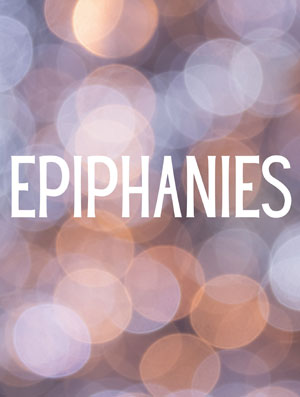EPIPHANIES
 Reflection by Sister Michael Brandt, OSB
Reflection by Sister Michael Brandt, OSB
January, the first month of the 21st year of the 21st century! And what richness and inspiration it provides us in terms of our celebrations of the Church Year – Mary Mother of God, Epiphany, Baptism of the Lord, Conversion of St. Paul, not to mention Elizabeth Ann Seton, John Neumann, and Thomas Aquinas.
How might we tie some of these Holy events together? I would suggest starting not with Epiphany, a way of referring to the manifestation of Christ to the Gentiles as represented by the Magi, but with epiphany. Merriam-Webster defines epiphany as an appearance, especially of a divine being, or an intuitive grasp of reality by means of something usually simple and striking or, on the other hand, as an illuminating discovery, realization, or disclosure.
Now isn’t that exactly what happened to Mary – appearance of a divine being/an illuminating disclosure?? Kathleen Norris, Benedictine Oblate and author of many books, suggests that epiphanies are not easy on us. Luke 1:29 notes that Mary was deeply troubled by the Angel’s greeting as he went on to disclose she was to be the mother of Jesus.
Then, the Baptism of Jesus. The crowds, including notables such as tax collectors and soldiers, clamored for John the Baptist to tell them what to do, and he did indeed counsel – “share what you have, do not cheat, don’t bully or denounce anyone falsely” – and he baptized them, including Jesus. And in an illuminating disclosure, “the holy Spirit descended upon him in bodily form like a dove. And a voice came from heaven, ‘You are my beloved Son, with you I am well pleased.’ ” Luke 3:21-22.
Another way of referring to what some call an epiphany is the “road to Damascus” moment, generally considered as an important point in someone’s life where a great change or reversal of ideas or beliefs occurs. Take St. John Neumann whose “road to Damascus” involved a great change, first directing him to work with immigrants, then to provide leadership in the Redemptorist order, next to establish the first parochial schools in the country, and finally to found a congregation of sisters. Did not Neumann’s efforts exemplify great change or reversal of ideas as to his life’s work?
The conversion of St. Paul is where the “road to Damascus” really comes in. Talk about an illuminating discovery, realization or disclosure. Remember Norris’ conviction that epiphanies are not easy on us? Being knocked to the ground and struck blind are hardly easy, but requisite to introducing the Gospel message beyond the Jewish people and proclaiming it to the wider world.
Lest you wonder, my intent is not to engage in a semantics lesson but to set the stage for exploring January’s Church Year celebrations as “road to Damascus” or “aha” moments. What comes of those, our reflections, remains to be seen. Each of us must and will experience something in our own way, our own time, during these liturgical occasions in January. The God of surprises! There is no telling what God has in store for us. An inspiration? An expectation? Who knows? I don’t, nor do you. The only thing we do know is that a “road to Damascus” moment such as St. Paul experienced will no doubt occur and that it may very well be a conversion or transformation which has been brought about by the grace of the Holy Spirit.
So remain open to the Spirit (as was Mary when she declared: “I am the servant of the Lord. Let it be done to me as you say.”) Let us leave room for God to work in our lives so that a great change or reversal of ideas or beliefs might occur, an epiphany, an “aha” moment!
